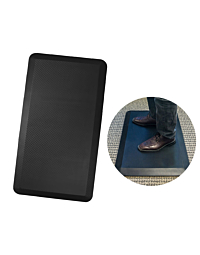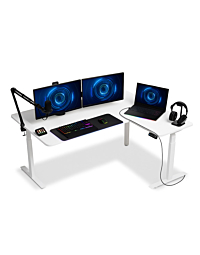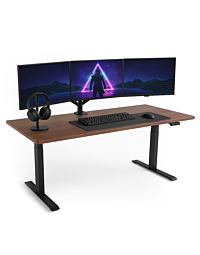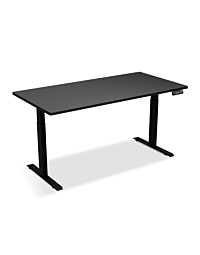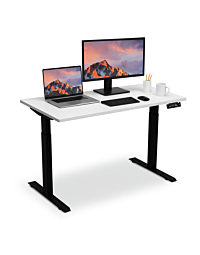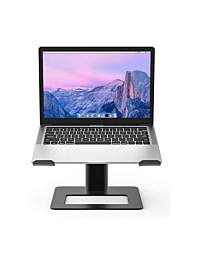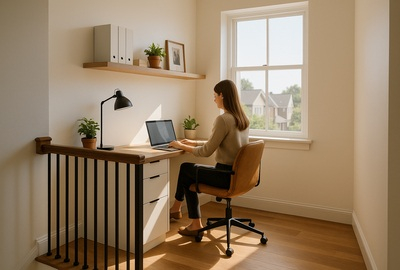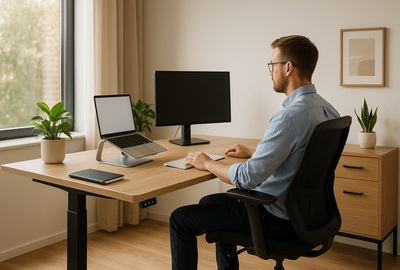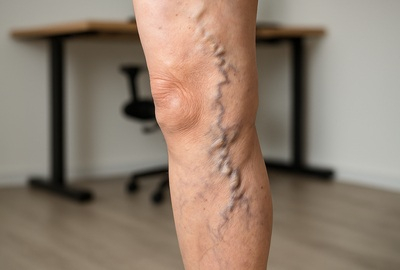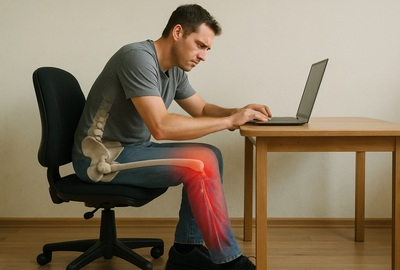- What is the 20-8-2 Rule?
- Does a Standing Desk Help Reduce Belly Fat?
- Is It OK to Stand at Your Desk All Day?
- Does Standing Burn More Calories Than Sitting?
- Is Standing for 8 Hours Better Than Sitting for 8 Hours?
- How Long Should You Stand a Day to Lose Weight?
- Is Standing for 12 Hours a Day Bad?
- How Many Hours a Day Should You Stand (Apple Watch)?
- Is It Worth Getting a Standing Desk?
- Is Standing for an Hour Better Than Sitting?
- What Are the Disadvantages of a Standing Desk?
- How Often Should I Switch Between Sitting and Standing?
Standing desks are a great tool, but they’re not a silver bullet. Whether you're using one to avoid back pain, boost focus, or just feel more active during the day — how and how long you stand really matters. Below, we break down the most common questions (and myths) about standing desks with straightforward advice, so you can make the most of your setup.
What is the 20-8-2 Rule?
The 20-8-2 rule is a simple way to break up every hour at your desk. It suggests sitting for 20 minutes, standing for 8, and moving for 2. It's backed by ergonomic experts to reduce stiffness, fatigue and improve circulation — especially in sedentary office jobs. It’s not about perfection; it’s about movement. If you’re glued to your chair for hours, this rhythm is a realistic way to keep your body happy and productive throughout the day.
- Use a smartwatch or phone timer to prompt you every 30–60 minutes. I personally love the Pomodoro Timer from Minimal Desk setups
- Take a walk around the office or do calf raises during the “2” movement phase.
- If you like keeping records and really want to run the numbers, log your sit-stand times to stay consistent throughout the week.
- You can't always leave your desk every 20 minutes so if this isn't practical just go for a quick stroll every 50 minutes or so.
- Going from not moving at all to moving just a little is a big improvement!
Does a Standing Desk Help Reduce Belly Fat?
Standing burns a few more calories than sitting, but let’s be clear — it won’t shrink belly fat on its own. What it does do is reduce sedentary time, which is linked to better metabolic health and lower risk of weight gain. If used alongside walking breaks and smart eating habits, it’s a small but helpful piece of the weight control puzzle. Think of standing desks as a trigger for an overall more active routine, not a weight loss machine.
- Add movement to your standing time — sway, pace on the spot or do calf raises every so often.
- Pair desk use with a daily 20–30 minute walk.
- Avoid snacking just because you’re upright — keep meals mindful.
- Consider investing in a mini stepper or a walking pad. (coming soon)
Is It OK to Stand at Your Desk All Day?
Nope — standing all day can be just as tough on the body as sitting all day. Prolonged standing can cause foot pain, varicose veins, and lower back issues. Your body’s not designed to stay still in any one position for hours. Standing desks are best used for alternating between sitting and standing — and for encouraging regular movement. If you’ve just made the switch, ease into it to avoid fatigue.
- Limit standing to 30–60 minutes at a time.
- Use an anti-fatigue mat and supportive shoes to reduce strain.
- Stretch or shift weight often while standing to keep blood flowing.
- An exception to the above would be if you are training for a marathon or ultra run.
Does Standing Burn More Calories Than Sitting?
Yes, but only slightly — we’re talking about an extra 10–20 calories an hour. Over a workweek, though, that can add up. More importantly, standing engages your leg muscles and encourages more frequent movement, which has a much bigger impact than the calories burned. So while it won’t replace your gym workout, standing can support a healthier daily rhythm and reduce health risks tied to prolonged sitting.
- Add movement while standing — leg lifts, pacing, or using a balance board.
- Track your time upright each day for consistency.
- Don’t just stand still — the benefits come from changing positions.
- A standing desk can be a reminder of your new and improved lifestyle, a gateway into a better lifestyle. Setting a reminder to stand and sit can also be a subtle reminder to keep moving not just at your desk but in your lifestyle choices as well!
Is Standing for 8 Hours Better Than Sitting for 8 Hours?
Not really sorry. Eight hours in any static position is hard on the body. What you want is variation. A mix of sitting, standing, and moving is the healthiest option. Standing too long can cause soreness and fatigue, just like sitting too long. Ideally, try to rotate positions throughout your workday to reduce pressure on joints and muscles.
- Use a height-adjustable desk to easily switch between sitting and standing.
- Break up your workday with 5-minute movement breaks every hour.
- Alternate positions based on tasks — stand for meetings or phone calls, sit for deep-focus work.
How Long Should You Stand a Day to Lose Weight?
There’s no magic number, but research suggests standing for 2–4 hours during a workday can help offset the negative effects of sitting — including weight gain. While standing alone won’t make the kilos melt off, it contributes to a more active lifestyle. The key is using it as a gateway to more movement. When you combine it with regular walking and healthy eating, it can support gradual, long-term weight loss.
- Stand for 30–60 minutes at a time, 4–6 times throughout the day.
- Use your standing time to do active tasks like walking meetings or organising files.
- Track your activity with a wearable or standing desk reminder app.
Is Standing for 12 Hours a Day Bad?
Yep! - Come on guys, anything in excess can have negative affects and standing for 12 hours straight without breaks is hard on your body. It can cause swelling, fatigue, joint strain, and poor circulation. Even retail and warehouse workers who stand for long shifts are advised to alternate positions and use rest periods. In an office, standing for that long isn’t necessary or recommended. Aim for balance, not extremes.
- Limit standing to a max of 4 hours in a full workday, with breaks.
- Elevate one foot occasionally (on a small box or footrest) to reduce lower back tension.
- Use a sit-stand timer app to avoid overdoing it.
How Many Hours a Day Should You Stand (Apple Watch)?
Apple Watch recommends standing for at least one minute every hour for 12 hours a day. It’s a simple prompt to break sedentary habits, but you can go beyond that. Standing for 2–4 cumulative hours throughout your workday — in short blocks — is a great goal. The Watch helps remind you to move, but it's up to you to decide what you do during that “stand” minute.
- Take full advantage of stand reminders — stretch or walk for a minute or two.
- Sync your standing schedule with Apple Health to track progress.
- Challenge yourself to increase standing time weekly until you hit 4 hours/day.
Is It Worth Getting a Standing Desk?
If you’re sitting 6–10 hours a day, yes — a standing desk is a game changer. It’s not just about standing, it’s about flexibility. Being able to shift posture, reduce back pain, and inject more movement into your day adds up over time. It's a long-term investment in your focus, health, and comfort. And with prices coming down and more options available, it’s easier than ever to find one that suits your workspace.
- Choose an electric model with memory presets for smooth transitions.
- Pair it with a quality ergonomic chair and monitor riser.
- Test the setup with a standing desk converter if you’re on the fence.
Is Standing for an Hour Better Than Sitting?
Generally, yes — standing for an hour (especially with light movement) is better for circulation, posture, and energy than sitting still. But standing statically for too long can also cause fatigue. Ideally, you want to alternate every 30–60 minutes and stay somewhat active while standing. The point is to avoid getting stuck in any one position.
- Do light stretches or calf raises during standing time.
- Set a goal to stand for 3–4 short blocks per day instead of one long stretch.
- Use a desk that adjusts quickly so you can respond to how your body feels.
What Are the Disadvantages of a Standing Desk?
Used incorrectly, a standing desk can cause discomfort — back pain, tired feet, and poor posture. That usually happens when people stand too long, lock their knees, or don’t have the right ergonomic setup. Like any tool, it works best when used with a bit of know-how. The solution isn’t to avoid standing desks, but to use them smarter.
- Adjust the desk height so your elbows are at 90° and screen at eye level.
- Use an anti-fatigue mat and shift your weight while standing.
- Don’t ditch your chair — rotate between sitting and standing throughout the day.
How Often Should I Switch Between Sitting and Standing?
Every 30 to 60 minutes is ideal. You don’t need to overthink it — just keep moving. Sit for focused tasks, stand for calls or brainstorming. The more natural and flexible your routine is, the easier it’ll be to stick with. Remember: it’s not about standing more, it’s about sitting less and moving more often.
- Set reminders or use desk timers to cue position changes.
- Associate certain tasks with standing (e.g. reading emails).
- Let comfort be your guide — shift when your body feels restless or tired.
At the end of the day, the key isn’t to stand all day — it’s to keep moving. A well-used standing desk helps you break out of the sit-all-day cycle, reduce discomfort, and build healthier habits over time. Whether you're just getting started or upgrading your setup, the right desk and accessories can make all the difference. Explore Deskup’s range of height-adjustable desks, ergonomic chairs, and accessories — all stocked locally and ready to ship across Australia.


 Buy Now, Pay Later
Buy Now, Pay Later Verified Rating
Verified Rating 

